 |
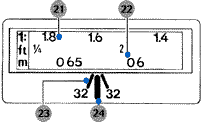 |
21. Reproduction
Ratio Scale 22. Distance scale 23. Depth of field Indicator 24. Distance Index * You can also use a black screw on the lens bayonet as the mounting index. |
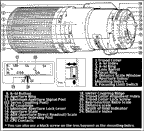 |
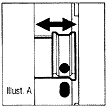 |
Minimum Aperture Lock: More info is available Below |
Main Features of the AF Micro-Nikkor ED 200mm f/4 D IF lens are: * Closest focus distance of 0.5m (1-5/6 ft.) * Distance information used for 3D Matrix Metering or the 3D Multi-Sensor Balanced Fill-Flash will be transmitted instantly from the lens to the camera body.
 |
|
| Standard accessories 62mm Snap-On front lens cap Rear lens cap LF-1 Hard lens case CL 45 |
Optional Accessories |
Recommended Focusing Screens Various interchangeable focusing screens are available for Nikon cameras to suit any type of lens or picture-taking situation. Those which are recommended for use with your lens are listed below:
|
Model/Screens |
EC-B |
A/L |
B |
C |
D |
E |
G1 |
G2 |
G3 |
G4 |
H1 |
H2 |
H3 |
H4 |
J |
K |
P |
M |
R |
T |
U |
F |
|
F5 + DP-30 |
|
|
|
(+0.5) |
|
|
|
|
(+0.5) |
|
|
|
|
|
|
|
|
|
|
|
|
|
|
F5 + DA-30 |
(+0.5) |
(+0.5) |
(+0.5) |
|
|
(+0.5) |
|
|
(-1.0) |
|
|
|
|
|
(+0.5 |
|
|
|
|
|
|
|
|
F4+DP-20 |
|
|
|
|
|
|
|
|
(-1.0) |
|
|
|
|
|
|
|
|
|
|
|
|
|
|
F4 + DA-20 |
|
|
|
|
|
|
|
|
(-1.0) |
|
|
|
|
|
|
|
|
|
|
|
|
|
|
F3 |
|
|
|
|
|
|
|
|
|
|
|
|
|
|
|
|
|
|
|
|
|
|
|
FE, FE2, FM2, FM2n, FA |
|
|
|
|
|
|
|
|
|
|
|
|
|
|
|
|
|
|
|
|
|
|
Excellent focusing |
Acceptable focusing; Slight vignetting or moire phenomenon affects screen image, but film image shows no traces of these. |
Not Applicable with screen type. Type M can be used for both macrophotography at 1:1 reproduction ratio and for photomicrography It has different application than other screens. Type K (K2), E (E2) and B (B2) for FM2, FM2n (And other FM2 series models); FE, FA and FE2, refer to this section for more info on compatibility issue on exposure compensation. |
Indicates degree of exposure compensation needed for F5-series or F4-series cameras (Center-Weighted metering only). For F5 camera, compensate using the Custom Setting #18 on the camera body. See instruction manual of the camera body for more details. For F4-series cameras, compensate using the Exposure Compensation Dial for the focusing screen. (See the F4/F4s instruction manual, page 78). Blank box means not applicable. Since type-M screen can be used for both macrophotography at a 1:1 magnification ratio and for photomicrography, it has different applications than other screens. For the K2, B2 and E2 focusing screens, refer to the columns on the K, B and E screens, respectively. For details, also refer to the specific camera's instruction manual. |
Presetting focus range In cases when you want to shoot within a specified distance range, you can reduce focusing time by setting the focus limit switch from FULL position to LIMIT. (There are two focusing limit zones; approx. 0.7m (2-1/4 ft.) to infinity for normal shooting, approx. 0.7m (2-1/4 ft) to 0.5m (1-5/6 ft.) for shooting at a close distance.)
Focusing at a predetermined reproduction ratio The reproduction ratio is the relation between the size of the image recorded on film and the actual subject size. If, for example, the image on the focusing screen is one-fifth the actual subject size, the reproduction ratio is 1: 5. To photograph at a predetermined reproduction ratio, use the following procedure:
1. Manually turn the focus ring until the desired reproduction scale number is aligned with the distance index. 2. Aim at the subject, then change your position, moving closer to or farther away from the subject, until the image in the viewfinder sharpens. To obtain the appropriate reproduction ratio for each focal distance, see the table below:
Photographic Range with Close-up Attachment Close-up attachment lens No. 5T, Close-up attachment lens Ho. 6T, PK-series Rings
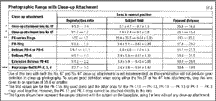 Click on table to download a copy for your future reference (PDF Format 73K) |
PN-Ring |
Depth
of Field The depth of field indicator lines are engraved beside the distance
index line. At close distances, however, so lisle is in focus that it may be more
useful to check the depth of field table (on the reverse side of this sheet). If
your camera has a depth of field preview button or depth of field preview lever,
you can check the depth of field in the viewfinder.
Minimum Aperture Lock (Illus. A) For programmed auto
or shutter-priority auto exposure shooting, use the minimum aperture lock lever to
lock the lens aperture at
f/32.
 |
1. Set the lens to its minimum aperture (f/32). |
Notes on Close-up Photography and Duplication Work Camera shake: The AF Micro-Nikkor ED 200mm f4 D IF provides such exceptionally high image magnification that even the slightest movement during shooting causes a blurred image. Be sure to mount the camera on a tripod and use a cable release or remote cord to release the shutter. Close working distances At the high reproduction ratios used in close-up shooting, the depth of field is very shallow. To ensure greater depth of field, stop down the lens, then carefully position the camera to ensure the most important surface of the subject is in the same zone of sharp focus. Exposure measurement with close-up attachments For a lens in normal position, see the following table. For a reverse-position lens, be sure to use stop-down measurement.
|
Camera Models |
Accessories |
Exposure measurement |
|
F90x/N90s ***, F90-Series/N90s***, F70-Series/N70s***, F4 series, F-801/N8008s***, F-801s/N8008s***); (CPU-AI); F3 series, FE, FM, EL2, Nikkormat FT3, F2 Photomic A, F2 Photomic AS (AI) |
PK-11A, 12, 13/PN-11 |
Full Aperture |
|
PK-2, 3/PN-1/Bellows |
Stopped Down * |
|
|
F
501/N2020, FE2, FA, FM2, FG, |
PK-11A, 12,13/PN-11 |
Full Aperture or light intensity feedback |
|
PK-2, 3/PN-1/Bellows |
Stopped Down * |
|
|
Non-AI bodies |
PK-11A, 12, 13/PN-11/Bellows |
Stopped Down * |
|
PK-2, 3/PN-1 |
Full Aperture ** |
Warning: The F-401s/N4004s*** exposure metering system will not work with PK-11A, PK-12, PK-13 or bellows.
* For stop-down exposure metering, refer your camera 's Instruction manual.
** Lens modification required After mounting modified lens, manually perform maximum aperture Indexing.
*** The Nikon N90s, N90, N70, N8008, N8008s and N4004s are sold exclusively in the US market;
**** The Nikon N2000 is sold exclusively in the US and Canadian markets.
Exposure Compensation At a close distance (at reproduction ratios 1:10 or greater), the amount of light reaching the film decreases as the lens-to-film distance increases. When shooting without PL exposure metering (i.e., when performing non-TTL auto flash photography, or when using a separate exposure meter, etc.), make exposure compensation while referring to the table below:
|
Reproduction Ratio |
Exposure Factor |
Amount of Exposure compensation (approx.) |
|
1:10 |
1.10 |
1/6 stop |
|
1:8 |
1.12 |
1/6 stop |
|
1:7 |
1.14 |
1/6 stop |
|
1:6 |
1.16 |
1/6 stop |
|
1:5 |
1.19 |
1/3 stop |
|
1:4 |
1.24 |
1/3 stop |
|
1:3 |
1.31 |
1/2 stop |
|
1:2.5 |
1.37 |
1/2 stop |
|
1:2 |
1.46 |
2/3 stop |
|
1:1.8 |
1.51 |
2/3 stop |
|
1:1.6 |
1.57 |
2/3 stop |
|
1:1.4 |
1.65 |
2/3 stop |
|
1:1.2 |
1.75 |
5/6 stop |
|
1:1.1 |
1.82 |
5/6 stop |
|
1:1 |
1.90 |
1 stop |
Note: To compensate exposure without increasing aperture more than one full f/stop, use slower shutter speeds. For example, for a 1:1.2 reproduction ratio, open the lens by 5/6 stop. Or use a shutter speed one step slower, then stop the lens down by 4/6 stop. |
||
Lens Care Clean lens surface with a blower brush. To remove dirt and smudges, use a soft, clean cotton cloth or lens tissue moistened with ethanol (alcohol) or lens cleaner. Wipe in a circular motion from center to outer edge, taking care not to leave traces and not to touch the other lens parts.
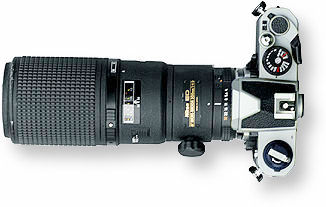 |
Never use thinner or benzine to clean the lens. To protect the lens surface from dirt or damage, the use of an NC filter is recommended at all times. The lens hood also helps to protect the lens. Keep the lens cap in place whenever the lens is not in use. If you will not use the lens for a long time, protect it from rust and mold by storing it in a cool, dry place. Also, do not store in direct sunlight, and keep it away from naphthalene or camphor.Be careful not to get the lens wet or drop it in water. Water on the lens may cause malfunction. Reinforced plastic is used on the exterior of the lens unit; to avoid damage, take extra care to never leave the lens in an excessively hot place. |
Important
Note
When using a separate exposure meter and setting the aperture according to value
indicated in the camera's LCD panel or in the viewfinder LCD, there is no need to
consider the exposure factor. Likewise, when setting aperture value with the aperture
dial of F-401 series cameras, the exposure compensation is unnecessary. However,
when setting aperture with the aperture ring of the lens or according to value indicated
in the viewfinder Aperture Direct Readout window, make exposure compensation while
referring to the table.
![]()
Technical
Specifications:-
Type of lense:
D-type AF Micro Nikkor lens with built-in CPU and Nikon bayonet mount
Focal
length: 200mm
Maximum aperture: f/4
Lens construction: 13 elements in 8 groups
Picture angle: 12°20'
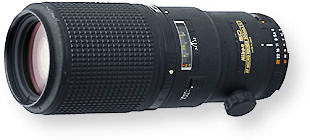 |
Distance scale: Graduated in meters and feet/inches from 0.5m (15/8 ft.) to infinity (OO) |
Copyright-free images collection © 2001
Aperture
scale: f/4 to f/32 on both standard and aperture-direct-readout scales
Minimum aperture lock: Provided
Diaphragm: Fully automatic Lens Coating: Nikon new SIC (Super Integrated Coating)
Exposure measurement: Via full-aperture method for AI cameras or cameras with
CPU interface system, via stop-down method for other cameras
Mount: Nikon bayonet mount
Attachment size: 62mm (P=0.75mm)
Tripod mounting: Built-in tripod mounting collar ratable through 360°
Standard accessories: 62mm Snap-On front lens cap; Rear lens cap LF-1; Hard
lens case CL 45
Optional Accessories: 62mm screw-in filters, Screw-in lens hood HN-30, CL-M2
case.
Dimensions: Approx. 76mm (3 inches) dia. x 1 93mm (7.6 inches) extension from
the camera's lens mounting flange; overall length is approx. 202mm (8 inches)
Weight: Approx. 1,200g (42.3 oz.)
Usable
Tele-Converters: - Nil (Nikon not advised to do so).
NOTE: Production Serial
Numbers believed to have started from 200001 for this AF lense
Relative: | AF-D Micro 200mm f/4.0s IF-ED | AF-D Zoom Micro-Nikkor 70-180mm f/4.5-f/5.6 ED | AF-D Micro 105mm f/2.8s | AF-D Micro 60mn f/2.8s | PC-Micro-Nikkor 85mm f/2.8D | MF Micro-Nikkor 55mm | MF Micro-Nikkor 105mm f/2.8 | f/4.0 | MF Micro-Nikkor 200mm f/4.0s IF | Other Nikkor prime of 180mm-200mm Telephotos | Other Nikkor prime of 105mm Telephotos | MF Medical-Nikkor 120mm f/4.0s | Medical-Nikkor 250mm f/5.6 | MF Bellow Nikkor 105mm f/4.0 | Bellow-Nikkor 135mm f/4.0 preset | UV-Nikkor 55mm f/4.0 | UV-Nikkor 105mm f/4.0s
| BACK | to Index page of AF Micro-Nikkor 200mm f/4.0D ED-IF
Micro-Nikkor
lense Family:
Main
Index Page
(3
parts)
| 50mm | 55mm (AF) | 60mm
(AF)
| 85mm
PC
| MF-105mm (AF) | MF-200mm (AF) | 70-180mm
(AF)
|
| Message Board |
for your
Nikkor
Optics
in a shared environment
| Message Board | Specifically for Dispose or Looking for new/used Nikon/Nikkor photographic equipment
| Nippon Kogaku Rangefinder Resources | Nikon F | Nikon F2 | Nikon F3 | Nikon F4 | Nikon F5 | Nikon F6 | Nikkormat / Nikomat | Nikon FM Series | Nikon FE/ FA | Nikon EM/FG/FG20 | Nikon Digital SLRs | Nikon - Other models |
Nikon MF RF-Nikkor lenses for Rangefinder
cameras:-
Main Index Page
Nikon
Auto Focus Nikkor lenses:- Main Index
Page
Nikon
Manual
Focus
Nikkor lenses:-
Fisheye-Nikkor Lenses - Circular |
Full Frame |
Ultrawides Lenses - 13mm15mm18mm20mm |
Wideangle Lenses - 24mm28mm35mm |
Standard Lenses - 45mm 50mm 58mm | Telephoto Lenses
- 85mm105mm135mm180mm & 200mm |
Super-Telephoto Lenses - 300mm 400mm 500mm 600mm 800mm 1200mm |
 |
Special Application
lenses: Micro-Nikkor Lenses - 50mm~55mm -60mm 85mm -105mm 200mm Micro-Zoom 70-180mm Perspective Control (PC) - 28mm 35mm PC-Micro 85mm Dedicated Lenses for Nikon F3AF: AF 80mm f/2.8 | AF 200mm f/3.5 EDIF Depth of Field Control (DC): 105mm 135mm Medical Nikkor: 120mm 200mm Reflex-Nikkor Lenses - 500mm 1000mm 2000mm Others: Noct Nikkor | OP-Nikkor | UV Nikkor 55mm 105mm | Focusing Units | Bellows-Nikkor 105mm 135mm Nikon Series E Lenses: 28mm35mm50mm100mm135mm | E-Series Zoom lenses: 36~72mm75~150mm70~210mm |
MF Zoom-Nikkor Lenses: 25~50mm | 28~45mm | 28~50mm | 28~85mm | 35~70mm | 36~72mm E | 35~85mm | 35~105mm | 35~135mm | 35~200mm | 43~86mm | 50~135mm | 50~300mm | 70~210mm E | 75~150mm E | 80~200mm | 85~250mm | 100~300mm | 180~600mm | 200~400mm | 200~600mm | 360~1200mm | 1200~1700mm
Tele-Converters: TC-1 | TC-2 | TC-200 | TC-201 | TC-300 | TC-301 | TC-14 | TC-14A | TC-14B | TC-14C | TC-14E | TC-16 | TC-16A | TC-20E
Recommended links to understand more technical details
related to the Nikkor F-mount and production Serial Number:
http://rick_oleson.tripod.com/index-153.html by: my
friend, Rick Oleson
http://www.zi.ku.dk/personal/lhhansen/photo/fmount.htm by: Hansen,
Lars Holst
http://www.mir.com.my/rb/photography/hardwares/nikonfmount/lens2.htm
http://www.photosynthesis.co.nz/nikon/serialno.html
Recommended Reading Reference on Nikon cameras and Nikkor lenses | about this photographic web site
| | Back | Main Index Page of Nikkor Resources | Back | Main Index Page of Pictorial History of Nikon SLRs |
| Home - Photography in Malaysia |
![]()
Credit: To all the good
people who has contributed their own experience, resources or those who are kind
enough granting us permission to use their images appeared in this site Note:certain
content and images appeared in this site were either scanned from official marketing
leaflets, brochures, sales manuals or publications published by Nikon over the years
and/or contribution from surfers who claimed originality of their work for educational
purposes. The creator of the site will not be responsible for may discrepancies arise
from such dispute except rectifying them after verification."Nikon", "Nikkormat", "Nippon Kokagu
KK"
& "Nikkor" are registered
tradename of Nikon Corporation Inc., Japan. Site made with an Apple IMac.